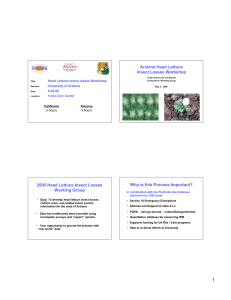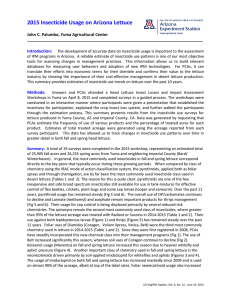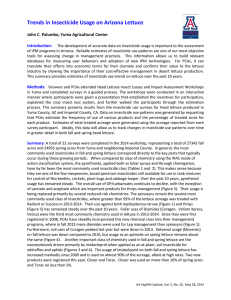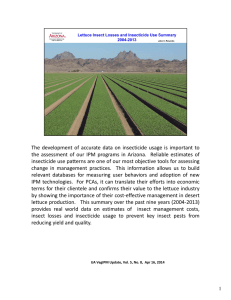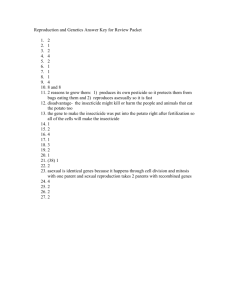Insecticide Use on Arizona Head Lettuce Introduction:
advertisement
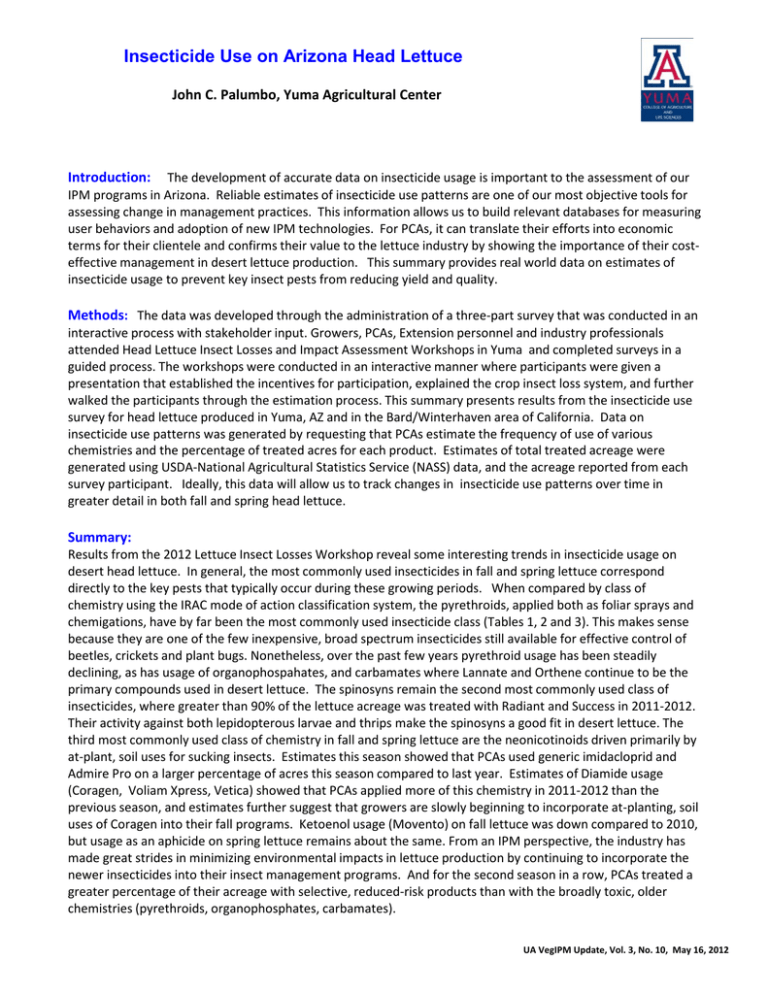
Insecticide Use on Arizona Head Lettuce John C. Palumbo, Yuma Agricultural Center Introduction: The development of accurate data on insecticide usage is important to the assessment of our IPM programs in Arizona. Reliable estimates of insecticide use patterns are one of our most objective tools for assessing change in management practices. This information allows us to build relevant databases for measuring user behaviors and adoption of new IPM technologies. For PCAs, it can translate their efforts into economic terms for their clientele and confirms their value to the lettuce industry by showing the importance of their costeffective management in desert lettuce production. This summary provides real world data on estimates of insecticide usage to prevent key insect pests from reducing yield and quality. Methods: The data was developed through the administration of a three-part survey that was conducted in an interactive process with stakeholder input. Growers, PCAs, Extension personnel and industry professionals attended Head Lettuce Insect Losses and Impact Assessment Workshops in Yuma and completed surveys in a guided process. The workshops were conducted in an interactive manner where participants were given a presentation that established the incentives for participation, explained the crop insect loss system, and further walked the participants through the estimation process. This summary presents results from the insecticide use survey for head lettuce produced in Yuma, AZ and in the Bard/Winterhaven area of California. Data on insecticide use patterns was generated by requesting that PCAs estimate the frequency of use of various chemistries and the percentage of treated acres for each product. Estimates of total treated acreage were generated using USDA-National Agricultural Statistics Service (NASS) data, and the acreage reported from each survey participant. Ideally, this data will allow us to track changes in insecticide use patterns over time in greater detail in both fall and spring head lettuce. Summary: Results from the 2012 Lettuce Insect Losses Workshop reveal some interesting trends in insecticide usage on desert head lettuce. In general, the most commonly used insecticides in fall and spring lettuce correspond directly to the key pests that typically occur during these growing periods. When compared by class of chemistry using the IRAC mode of action classification system, the pyrethroids, applied both as foliar sprays and chemigations, have by far been the most commonly used insecticide class (Tables 1, 2 and 3). This makes sense because they are one of the few inexpensive, broad spectrum insecticides still available for effective control of beetles, crickets and plant bugs. Nonetheless, over the past few years pyrethroid usage has been steadily declining, as has usage of organophospahates, and carbamates where Lannate and Orthene continue to be the primary compounds used in desert lettuce. The spinosyns remain the second most commonly used class of insecticides, where greater than 90% of the lettuce acreage was treated with Radiant and Success in 2011-2012. Their activity against both lepidopterous larvae and thrips make the spinosyns a good fit in desert lettuce. The third most commonly used class of chemistry in fall and spring lettuce are the neonicotinoids driven primarily by at-plant, soil uses for sucking insects. Estimates this season showed that PCAs used generic imidacloprid and Admire Pro on a larger percentage of acres this season compared to last year. Estimates of Diamide usage (Coragen, Voliam Xpress, Vetica) showed that PCAs applied more of this chemistry in 2011-2012 than the previous season, and estimates further suggest that growers are slowly beginning to incorporate at-planting, soil uses of Coragen into their fall programs. Ketoenol usage (Movento) on fall lettuce was down compared to 2010, but usage as an aphicide on spring lettuce remains about the same. From an IPM perspective, the industry has made great strides in minimizing environmental impacts in lettuce production by continuing to incorporate the newer insecticides into their insect management programs. And for the second season in a row, PCAs treated a greater percentage of their acreage with selective, reduced-risk products than with the broadly toxic, older chemistries (pyrethroids, organophosphates, carbamates). UA VegIPM Update, Vol. 3, No. 10, May 16, 2012 Table 1. Estimated Insecticide Usage on Head Lettuce in Yuma, Arizona in 2011 and 2012 based on PCA surveys. Estimated no. of Head Lettuce Acres Treated1 (total acres in production based on NASS figures) Chemistry or A.I. Primary products 2011 2012 IRAC MOA (46000) (44000) Old chemistry , Broad Spectrum and Broadly Toxic Pyrethroids various 3A 140,976 123,345 Carbamates Lannate 1A 23,684 17,988 Organophosphates Orthene 1B 9,817 14,512 Cyclodienes Endosulfan 2A 3,847 253 178,324 156,098 Newer Chemistry, Selective and Reduced risk Spinosyns Radiant 5 87,958 84,856 Neonicotinoids Imidacloprid 4A 38,187 39,629 Diamides Coragen, Vetica 28 16,980 18,833 Diacylhydrazines Intrepid 18 7,340 2,875 Ketoenols Movento 23 20,511 15,525 Flonicamid Beleaf 9C 3,208 2,059 Indoxacarb Avaunt 22 748 173 Buprofezin Vetica 16 2,509 6,452 Avermectins Proclaim 6 17,210 8,429 Pymetrozine Fulfill 9B 425 0 B. thuringiensis Dipel 11 0 92 195,076 178,923 1 totals estimated by multiplying : % reported acres treated*number of times treated * NASS acreage estimated in each year for AZ (an additional 10,000 acres were included with NASS estimates for lettuce grown in the Bard/Winterhaven area, of California) UA VegIPM Update, Vol. 3, No. 10, May 16, 2012 Table 2. The 15 Most Commonly Applied Insecticides in Fall Head Lettuce, 2011 Fall Lettuce 2010 2011 (21,542 ac reported) (23,245 ac reported) % acres treated Avg. no. applied Total 1 acres treated % acres treated Avg. no. applied Total 1 acres treated Pyrethroid (Foliar) 99.6 3 64,367 1 Pyrethroid (Foliar) 97.1 2.5 56,427 Radiant 85.4 2.1 38,633 2 Radiant 87.1 2.1 42,517 Generic Imidacloprid 54.8 1 11,805 3 Generic Imidacloprid 56.4 1 13,110 Proclaim 44.6 1.1 10,569 4 Pyrethroid (Chemigated) 48.9 1 11,367 Lannate 33.5 1.4 10,103 5 Lannate 33.3 1 7,741 Pyrethroid (Chemigated) 43.8 1 9,435 6 Admire Pro 31.1 1 7,229 Movento 28.4 1.2 7,342 7 Proclaim 26.9 1.1 6,878 Success 19.3 1.2 4,989 8 Voliam Xpress 21.4 1.2 5,969 Vetica 14.4 1.1 3,412 9 Vetica 19.7 1.2 5,495 Intrepid 13.5 1.1 3,199 10 Coragen (Soil, at plant) 17.9 1 4,161 Admire_Pro 14.6 1 3,145 11 10.1 1.4 3,287 Orthene 13.1 1.1 3,104 12 Orthene 11.3 1.2 3,152 Voliam Xpress 13.8 1 2,973 13 Coragen (Foliar) 12.1 1 2,813 Assail 12.3 1.1 2,915 14 Intrepid 9.2 1 2,139 Coragen (Soil, at plant) 9.0 1 1,939 15 Success 5.8 1.5 2,022 Insecticide Insecticide Movento 1 Total acres treated estimated by multiplying : % acres treated * number of times treated * acreage estimated by participating PCAs in the 2012 survey. UA VegIPM Update, Vol. 3, No. 10, May 16, 2012 Table 3. The 15 Most Commonly Applied Insecticides in Spring Head Lettuce, 2012 Spring Lettuce 2011 2012 (17,280 ac reported) (17,420 ac reported) % acres treated Avg. no. applied Total 1 acres treated % acres treated Avg. no. applied Total 1 acres treated Pyrethroid (Foliar) 99.5 2.6 44,703 1 Pyrethroid (Foliar) 93.1 2.1 34,058 Radiant 90.0 2 31,104 2 Radiant 87.5 1.9 28,961 Lannate 47.1 1.3 10,581 3 Generic Imidacloprid 63.6 1 11,079 Movento 42.7 1.3 9,592 4 Orthene 41.2 1.2 8,612 Generic Imidacloprid 46.6 1 8,052 5 Movento 43.9 1.1 8,412 Pyrethroid (Chemigated) 32.1 1 5,547 6 Lannate 37.8 1.2 7,902 Proclaim 30.9 1 5,340 7 Pyrethroid (Chemigated) 22.2 1 3,867 Assail 23.7 1.2 4,914 8 Admire_Pro 21.5 1 3,745 Success 22.8 1.2 4,728 9 Beleaf 17.9 1 3,118 Orthene 24.4 1.1 4,638 10 Assail 12.5 1 2,178 Admire_Pro 17.5 1 3,024 11 Proclaim 7.7 1 1,341 Beleaf 13.2 1.3 2,965 12 Success 7.7 1 1,341 Intrepid 15.4 1 2,661 13 Vetica 5.8 1 1,010 Vetica 12.2 1.1 2,319 14 Voliam Xpress 3.8 1 662 Voliam Xpress 8.3 1 1,434 15 Intrepid 3.3 1 575 Insecticide Insecticide 1 Total acres treated estimated by multiplying : % acres treated * number of times treated * acreage estimated by participating PCAs in the 2012 survey. UA VegIPM Update, Vol. 3, No. 10, May 16, 2012


